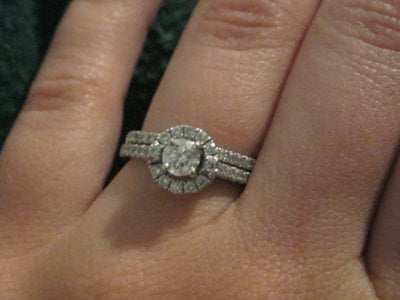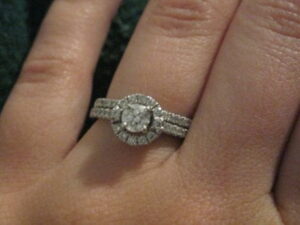http://www.businessinsider.com/why-diamonds-are-a-sham-2013-3
“Yeah, they say three years’ salary.” — Michael Scott, The Office
American males enter adulthood through a peculiar rite of passage – they spend most of their savings on a shiny piece of rock.
They could invest the money in assets that will compound over time and someday provide a nest egg.
Instead, they trade that money for a diamond ring, which isn’t much of an asset at all. As soon as you leave the jeweler with a diamond, it loses over 50% of its value.
Americans exchange diamond rings as part of the engagement process, because in 1938 De Beersdecided that they would like us to. Prior to a stunningly successful marketing campaign 1938, Americans occasionally exchanged engagement rings, but wasn’t a pervasive occurrence.
Not only is the demand for diamonds a marketing invention, but diamonds aren’t actually that rare. Only by carefully restricting the supply has De Beers kept the price of a diamond high.
Countless American dudes will attest that the societal obligation to furnish a diamond engagement ring is both stressful and expensive. But here’s the thing – this obligation only exists because the company that stands to profit from it willed it into existence.
So here is a modest proposal: Let’s agree that diamonds are bullshit and reject their role in the marriage process. Let’s admit that as a society we got tricked for about century into coveting sparkling pieces of carbon, but it’s time to end the nonsense.
The Concept of Intrinsic Value
In finance, there is concept called intrinsic value. An asset’s value is essentially driven by the (discounted) value of the future cash that asset will generate. For example, when Hertz buys a car, its value is the profit they get from renting it out and selling the car at the end of its life (the “terminal value”). For Hertz, a car is an investment. When you buy a car, unless you make money from it somehow, its value corresponds to its resale value. Since a car is a depreciating asset, the amount of value that the car loses over its lifetime is a very real expense you pay.
A diamond is a depreciating asset masquerading as an investment. There is a common misconception that jewelry and precious metals are assets that can store value, appreciate, and hedge against inflation. That’s not wholly untrue.
Gold and silver are commodities that can be purchased on financial markets. They can appreciate and hold value in times of inflation. You can even hoard gold under your bed and buy gold coins and bullion (albeit at a ~10% premium to market rates). If you want to hoard gold jewelry however, there is typically a 100-400% retail markup so that’s probably not a wise investment.
But with that caveat in mind, the market for gold is fairly liquid and gold is fungible – you can trade one large piece of gold for ten smalls ones like you can a ten dollar bill for a ten one dollar bills. These characteristics make it a feasible potential investment.
Diamonds, however, are not an investment. The market for them is neither liquid nor are they fungible.
The first test of a liquid market is whether you can resell a diamond. In a famous piece published by The Atlantic in 1982, Edward Epstein explains why you can’t sell used diamonds for anything but a pittance:
Retail jewelers, especially the prestigious Fifth Avenue stores, prefer not to buy back diamonds from customers, because the offer they would make would most likely be considered ridiculously low. The “keystone,” or markup, on a diamond and its setting may range from 100 to 200 percent, depending on the policy of the store; if it bought diamonds back from customers, it would have to buy them back at wholesale prices.
…
Most jewelers would prefer not to make a customer an offer that might be deemed insulting and also might undercut the widely held notion that diamonds go up in value. Moreover, since retailers generally receive their diamonds from wholesalers on consignment, and need not pay for them until they are sold, they would not readily risk their own cash to buy diamonds from customers.
When you buy a diamond, you buy it at retail, which is a 100% to 200% markup. If you want to resell it, you have to pay less than wholesale to incent a diamond buyer to risk their own capital on the purchase. Given the large markup, this will mean a substantial loss on your part. The same article puts some numbers around the dilemma:
Because of the steep markup on diamonds, individuals who buy retail and in effect sell wholesale often suffer enormous losses. For example, Brod estimates that a half-carat diamond ring, which might cost $2,000 at a retail jewelry store, could be sold for only $600 at Empire.
Some diamonds are perhaps investment grade, but you probably don’t own one, even if you spent a lot.
The appraisers at Empire Diamonds examine thousands of diamonds a month but rarely turn up a diamond of extraordinary quality. Almost all the diamonds they find are slightly flawed, off-color, commercial-grade diamonds. The chief appraiser says, “When most of these diamonds were purchased, American women were concerned with the size of the diamond, not its intrinsic quality.” He points out that the setting frequently conceals flaws, and adds, “The sort of flawless, investment-grade diamond one reads about is almost never found in jewelry.”
As with televisions and mattresses, the diamond classification scheme is extremely complicated. Diamonds are not fungible and can’t be easily exchanged with each other. Diamond professionals use the 4 C’s when classifying and pricing diamonds: carats, color, cut, and clarity. Due to the complexity of these 4 dimensions, it’s hard to make apples to apples comparisons between diamonds.
But even when looking at the value of one stone, professionals seem like they’re just making up diamond prices:
In 1977, for example, Jewelers’ Circular Keystone polled a large number of retail dealers and found a difference of over 100 percent in offers for the same quality of investment-grade diamonds.
So let’s be very clear, a diamond is not an investment. You might want one because it looks pretty or its status symbol to have a “massive rock”, but not because it will store value or appreciate in value.
But among all the pretty, shiny things out there – gold and silver, rubies and emeralds – why do Americans covet diamond engagement rings in the first place?
A Diamond is Forever a Measure of your Manhood
“The reason you haven’t felt it is because it doesn’t exist. What you call love was invented by guys like me, to sell nylons.” — Don Draper, Madmen
We like diamonds because Gerold M. Lauck told us to. Until the mid 20th century, diamond engagement rings were a small and dying industry in America. Nor had the concept really taken hold in Europe. Moreover, with Europe on the verge of war, it didn’t seem like a promising place to invest.
Not surprisingly, the American market for diamond engagement rings began to shrink during the Great Depression. Sales volume declined and the buyers that remained purchased increasingly smaller stones. But the US market for engagement rings was still 75% of De Beers’ sales. If De Beers was going to grow, it had to reverse the trend.
And so, in 1938, De Beers turned to Madison Avenue for help. They hired Gerold Lauck and the N. W. Ayer advertising agency, who commissioned a study with some astute observations. Men were the key to the market:
Since “young men buy over 90% of all engagement rings” it would be crucial to inculcate in them the idea that diamonds were a gift of love: the larger and finer the diamond, the greater the expression of love. Similarly, young women had to be encouraged to view diamonds as an integral part of any romantic courtship.
However, there was a dilemma. Many smart and prosperous women didn’t want diamond engagement rings. They wanted to be different.
The millions of brides and brides-to-be are subjected to at least two important pressures that work against the diamond engagement ring. Among the more prosperous, there is the sophisticated urge to be different as a means of being smart…. the lower-income groups would like to show more for the money than they can find in the diamond they can afford…
Lauck needed to sell a product that people either did not want or could not afford. His solution would haunt men for generations. He advised that De Beers market diamonds as a status symbol:
“The substantial diamond gift can be made a more widely sought symbol of personal and family success — an expression of socio-economic achievement.”
…
“Promote the diamond as one material object which can reflect, in a very personal way, a man’s … success in life.”
The next time you look at a diamond, consider this. Nearly every American marriage begins with a diamond because a bunch of rich white men in the 1940s convinced everyone that its size determines your self worth. They created this convention – that unless a man purchases (an intrinsically useless) diamond, his life is a failure – while sitting in a room, racking their brains on how to sell diamonds that no one wanted.
With this insight, they began marketing diamonds as a symbol of status and love:Movie idols, the paragons of romance for the mass audience, would be given diamonds to use as their symbols of indestructible love. In addition, the agency suggested offering stories and society photographs to selected magazines and newspapers which would reinforce the link between diamonds and romance. Stories would stress the size of diamonds that celebrities presented to their loved ones, and photographs would conspicuously show the glittering stone on the hand of a well-known woman.
Fashion designers would talk on radio programs about the “trend towards diamonds” that Ayer planned to start. The Ayer plan also envisioned using the British royal family to help foster the romantic allure of diamonds.
Even the royal family was in on the hoax! The campaign paid immediate dividends. Within 3 years, despite the Great Depression, diamond sales in the US increased 55%! Twenty years later, an entire generation believed that an expensive diamond ring was a necessary step in the marriage process.
The De Beers marketing machine continued to churn out the hits. They circulated marketing materials suggesting, apropos of nothing, that a man should spend one month’s salary on a diamond ring. It worked so well that De Beers arbitrarily decided to increase the suggestion to two months salary. That’s why you think that you need to spend two month’s salary on a ring – because the suppliers of the product said so.
Today, over 80% of women in the US receive diamond rings when they get engaged. The domination is complete.
A History of Market Manipulation
What, you might ask, could top institutionalizing demand for a useless product out of thin air? Monopolizing the supply of diamonds for over a century to make that useless product extremely expensive. You see, diamonds aren’t really even that rare.
Before 1870, diamonds were very rare. They typically ended up in a Maharaja’s crown or a royal necklace. In 1870, enormous deposits of diamonds were discovered in Kimberley, South Africa. As diamonds flooded the market, the financiers of the mines realized they were making their own investments worthless. As they mined more and more diamonds, they became less scarce and their price dropped.
The diamond market may have bottomed out were it not for an enterprising individual by the name of Cecil Rhodes. He began buying up mines in order to control the output and keep the price of diamonds high. By 1888, Rhodes controlled the entire South African diamond supply, and in turn, essentially the entire world supply. One of the companies he acquired was eponymously named after its founders, the De Beers brothers.
read more: http://www.businessinsider.com/why-diamonds-are-a-sham-2013-3
Disclaimer: We at Prepare for Change (PFC) bring you information that is not offered by the mainstream news, and therefore may seem controversial. The opinions, views, statements, and/or information we present are not necessarily promoted, endorsed, espoused, or agreed to by Prepare for Change, its leadership Council, members, those who work with PFC, or those who read its content. However, they are hopefully provocative. Please use discernment! Use logical thinking, your own intuition and your own connection with Source, Spirit and Natural Laws to help you determine what is true and what is not. By sharing information and seeding dialogue, it is our goal to raise consciousness and awareness of higher truths to free us from enslavement of the matrix in this material realm.
 EN
EN




























“Let’s zoom in to ‘value investing strategy’ that suits you the best.
Article by G Kumar, astrologer, academician &
programmer of. ‘Tulip mania’ refers to a tiume in the Dutch Golden Age when tthe contract prices for tulip bulbs escalated to
extraordinary heights, and then sharply collapsed.”
“Hello every one, here every one is sharing such familiarity, so it’s fastidious to read this webpage, and
I used to go to see this blog all the time.”